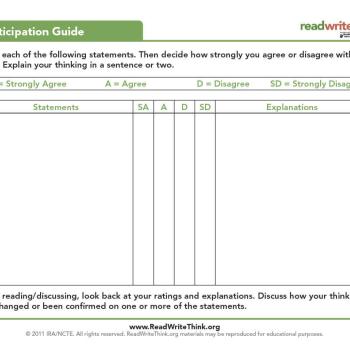Anticipation Guide

About this printout
Help establish a purpose for reading-and generate post-reading reflection and discussion-with this guide.
Teaching with this printout
When teaching fiction, generate a list of compelling or controversial thematic or topic-based statements that relate to key ideas of the short story, novel, or play students are about to read. List those statements in the left hand column and ask students to rate their level of agreement for each. Then have students explain why they chose their level of agreement by writing a short rationale. Explain to students that they should be thinking about these compelling thematic or topic-based statements as they read.
After they have read, pass back the guide and ask students to reflect on their current thinking. Have students write reflective statements that indicate how their attitudes or opinions have changed and facilitate small- or large-group discussions to explore those dynamics.
More ideas to try
- For a nonfiction piece, choose interesting or compelling facts or ideas about which students will read. Include some just as they are presented in the text; for others, reverse the truth of the statement to make it more controversial or more appealing to common sense. Follow the same instructional steps as above.
- Though an anticipation guide works well as pre- and post-reading activity, it can be applied to any learning experience. Use with video or film presentations, guest speakers, or field trips to help focus students' attention on key learning goals.
- After students are familiar with anticipation guides, "let them in" on the thinking you use to choose the statements in the left-hand column. Using text that is at or close to their independent reading level, ask students to make an anticipation guide that they could share with their peers.